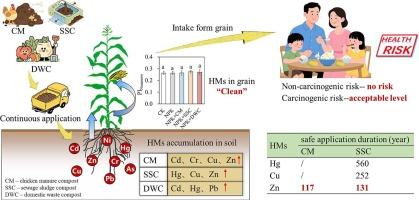Decoupling total accumulation from ecological and health risks: speciation stabilization of heavy metal(loid)s in soil-maize systems under 16-year application of various organic fertilizers
IF 9.7
1区 环境科学与生态学
Q1 ENVIRONMENTAL SCIENCES
引用次数: 0
Abstract
Long-term application of organic composts is known to enhance soil heavy metal (loid)s (HMs) accumulation; yet the dynamic speciation-bioaccumulation-health risks affected by various organic composts remain unclear. To address this knowledge gap, a 16-year field experiment assessed the effects of chicken manure (CM), sewage sludge composts (SSC), and domestic waste composts (DWC) on the accumulation, speciation, and bioavailability of eight HMs in a soil-maize system. The results showed that continuous application of CM, SSC, and DWC at 6 t ha−1 increased soil concentrations of Cd by 20–38 %, Cr by 8–16 %, Cu by 9–21 %, Zn by 17–37 %, and Hg by 82–350 % compared to control or chemical fertilizer treatments, with SSC showing the highest Hg accumulation (306–350 % increase). A moderate ecological risk was observed in SSC-treated plots, while other treatments posed low ecological risks. Organic fertilizer application promoted the HM stabilization: e.g. the proportion of stable fraction for Cd increased from 64 to 65–70 % under organic treatments. Such stabilization reduced bioaccumulation factors of Hg, Cd, and Zn by 42–78 %, resulting in no significant increase in HM concentrations in maize grains or health risks. Safe application durations are first estimated as 117 and 131 years for CM and SSC application (limited by Zn), respectively, and theoretically unlimited for DWC. The study concludes that stabilization of HM speciation and regulated application rates of organic fertilizers can decouple total HM accumulation from ecological and health risks. These findings provide practical guidance for the sustainable recycling of organic waste resources while ensuring environmental and food safety.

从生态和健康风险中解耦总积累:不同有机肥16年土壤-玉米系统重金属形态稳定
众所周知,长期施用有机堆肥会增加土壤重金属(HMs)的积累;然而,各种有机堆肥对动态物种-生物积累-健康风险的影响仍不清楚。为了解决这一知识缺口,一项为期16年的田间试验评估了鸡粪(CM)、污水污泥堆肥(SSC)和生活垃圾堆肥(DWC)对土壤-玉米系统中8种有机质的积累、物种形成和生物利用度的影响。结果表明,与对照或化肥处理相比,连续施用6 t ha - 1 CM、SSC和DWC可使土壤Cd、Cr、Cu、Zn、Zn、Hg分别提高20-38 %、8-16 %、9-21 %、17-37 %和82-350 %,其中SSC的Hg累积量最高(增加306-350 %)。ssc处理地块的生态风险中等,其他处理地块的生态风险较低。有机肥的施用促进了HM的稳定化,其中Cd稳定组分的比例从64 %提高到65 ~ 70 %。这种稳定使汞、镉和锌的生物积累因子降低了42 - 78% %,导致玉米籽粒HM浓度没有显著增加或健康风险。首先估计CM和SSC应用的安全持续时间分别为117和131 年(受Zn限制),而DWC理论上是无限的。研究表明,稳定土壤有机质形态和调控有机肥施用量可使土壤有机质积累总量与生态和健康风险解耦。这些研究结果为有机废弃物资源的可持续回收利用提供了实践指导,同时确保环境和食品安全。
本文章由计算机程序翻译,如有差异,请以英文原文为准。
求助全文
约1分钟内获得全文
求助全文
来源期刊

Environment International
环境科学-环境科学
CiteScore
21.90
自引率
3.40%
发文量
734
审稿时长
2.8 months
期刊介绍:
Environmental Health publishes manuscripts focusing on critical aspects of environmental and occupational medicine, including studies in toxicology and epidemiology, to illuminate the human health implications of exposure to environmental hazards. The journal adopts an open-access model and practices open peer review.
It caters to scientists and practitioners across all environmental science domains, directly or indirectly impacting human health and well-being. With a commitment to enhancing the prevention of environmentally-related health risks, Environmental Health serves as a public health journal for the community and scientists engaged in matters of public health significance concerning the environment.
 求助内容:
求助内容: 应助结果提醒方式:
应助结果提醒方式:


